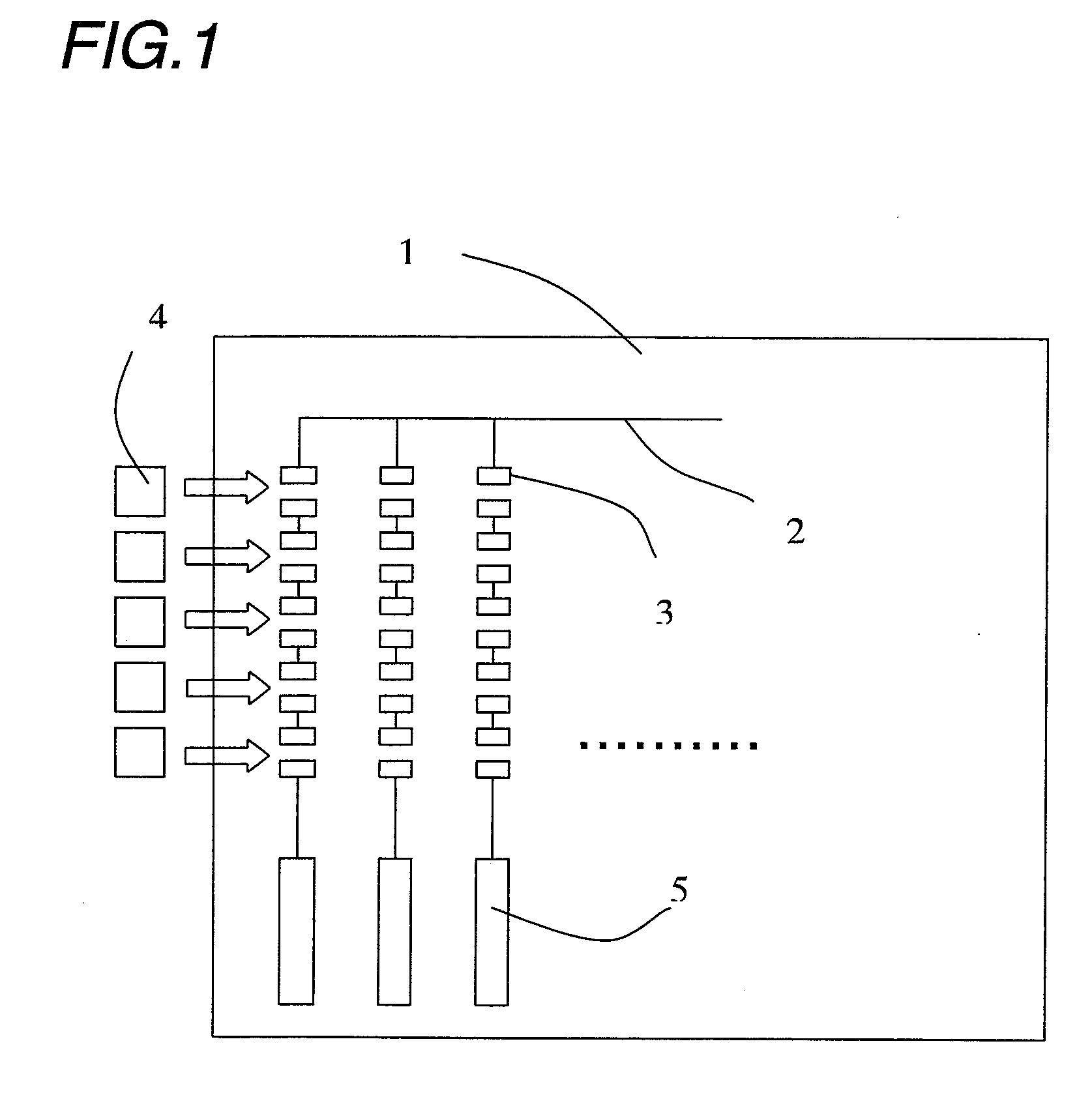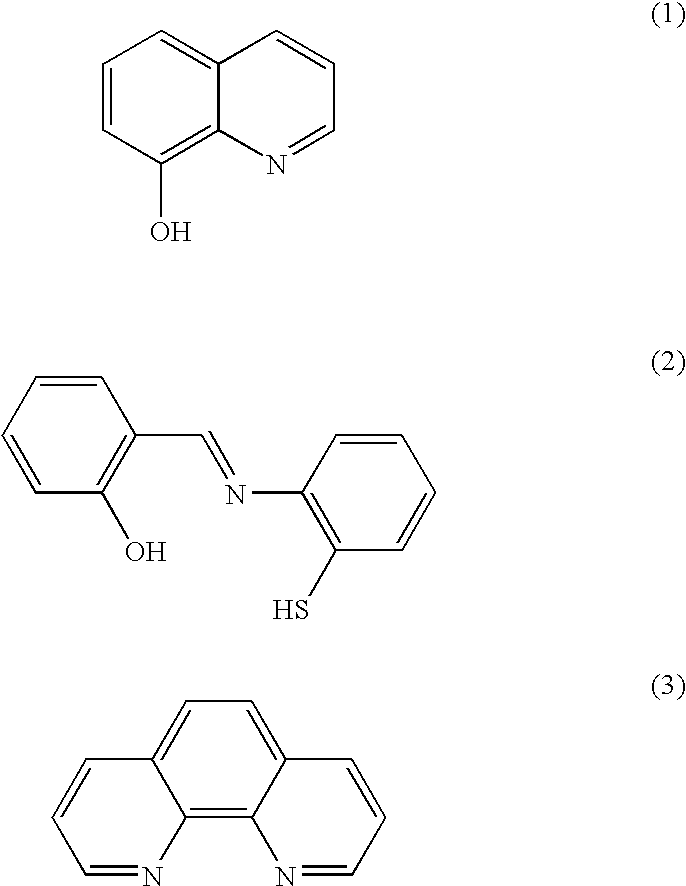Conductive adhesive
Inactive Publication Date: 2010-02-25
HENKEL ABLESTIK JAPAN +1
View PDF10 Cites 7 Cited by
- Summary
- Abstract
- Description
- Claims
- Application Information
AI Technical Summary
Benefits of technology
[0010]The conductive adhesive of the present invention is characterized by adding at least one member selected from among a chelator, an antioxidant, and a metal surfactant to a resin (base resin) and silver-tin filler system as an additive for lowering the value of contact resistance.
Problems solved by technology
However, solder is a lead-tin alloy and if the solder used in discarded electronic equipment is dissolved by acid rain, it might dissolve into the underground water to present a potential impact on the environment.
A further problem with the use of solder in connecting substrate electrodes to electronic components is that if cyclic stresses are applied, failure occurs from metal fatigue, occasionally causing cracks in connections.
Silver, the most common conductive filler, involves the problem of migration upon application of a voltage and this problem is substantial in the case of printing the conductive adhesive on the substrate by fine-line screen printing.
Use of this silver-tin alloy powder filler dissolves the problem of migration but then its high resistance value prevents it from attaining a practically feasible level of performance when used in packaging electronic components onto substrate electrodes.
With a view to solving this problem of high resistance values, it has been proposed that the powder of a low-melting alloy, for example, a tin-bismuth alloy, be added to the silver-tin filler; however, this approach is not adequately effective in reducing the contact resistance and, what is more, the addition of the tin-bismuth alloy powder requires temperatures as high as about 180° C. to cure the adhesive.
Method used
the structure of the environmentally friendly knitted fabric provided by the present invention; figure 2 Flow chart of the yarn wrapping machine for environmentally friendly knitted fabrics and storage devices; image 3 Is the parameter map of the yarn covering machine
View moreImage
Smart Image Click on the blue labels to locate them in the text.
Smart ImageViewing Examples
Examples
Experimental program
Comparison scheme
Effect test
examples
[0037]The present invention is described more specifically by means of the following examples. It should be noted that the present invention is by no means limited by the following description.
the structure of the environmentally friendly knitted fabric provided by the present invention; figure 2 Flow chart of the yarn wrapping machine for environmentally friendly knitted fabrics and storage devices; image 3 Is the parameter map of the yarn covering machine
Login to View More PUM
| Property | Measurement | Unit |
|---|---|---|
| Temperature | aaaaa | aaaaa |
| Temperature | aaaaa | aaaaa |
| Time | aaaaa | aaaaa |
Login to View More
Abstract
Conductive adhesives, which do not have the problem of migration in conductive metals upon application of a voltage and which exhibit low resistance values, are provided.One embodiment of the present invention relates to a conductive adhesive comprising a conductive filler and a resin, characterized in that the conductive filler comprises an alloy powder of silver and tin and further contains an additive comprising at least one member selected from among a chelator, an antioxidant, and a metal surfactant. Additives that can be used are chelators such as hydroxyquinolines, salicylidene aminothiophenols or phenanthrolines, antioxidants such as hydroquinones or benzotriazoles, and metal surfactants such as organic acids, acid anhydrides or organic acid salts.
Description
TECHNICAL FIELD[0001]The present invention relates to conductive adhesives and, more particularly, to conductive adhesives that can be used in packaging electronic components such as semiconductor devices by connecting them onto substrates.BACKGROUND ART[0002]For packaging electronic components, flip-chip solder bonding and the like have conventionally been adopted to connect them to electrodes on substrate surfaces. However, solder is a lead-tin alloy and if the solder used in discarded electronic equipment is dissolved by acid rain, it might dissolve into the underground water to present a potential impact on the environment. As a lead-free packaging technology, it has been proposed that a conductive adhesive be used instead of the conventional solder in connecting substrate electrodes to electronic components. A further problem with the use of solder in connecting substrate electrodes to electronic components is that if cyclic stresses are applied, failure occurs from metal fatig...
Claims
the structure of the environmentally friendly knitted fabric provided by the present invention; figure 2 Flow chart of the yarn wrapping machine for environmentally friendly knitted fabrics and storage devices; image 3 Is the parameter map of the yarn covering machine
Login to View More Application Information
Patent Timeline
 Login to View More
Login to View More IPC IPC(8): H01B1/22H05K1/02
CPCC08K3/08C08K5/0008C08K5/3437C08K5/378H05K2203/122C09J11/02H05K3/321H05K2201/0769H05K2203/121C09J9/02
Inventor WATANABE, BUNYATOIDA, GO
Owner HENKEL ABLESTIK JAPAN
Features
- R&D
- Intellectual Property
- Life Sciences
- Materials
- Tech Scout
Why Patsnap Eureka
- Unparalleled Data Quality
- Higher Quality Content
- 60% Fewer Hallucinations
Social media
Patsnap Eureka Blog
Learn More Browse by: Latest US Patents, China's latest patents, Technical Efficacy Thesaurus, Application Domain, Technology Topic, Popular Technical Reports.
© 2025 PatSnap. All rights reserved.Legal|Privacy policy|Modern Slavery Act Transparency Statement|Sitemap|About US| Contact US: help@patsnap.com



